- Home
- Edgar Allan Poe
The Works of Edgar Allan Poe — Volume 2 Page 23
The Works of Edgar Allan Poe — Volume 2 Read online
Page 23
NOTES TO THIS VOLUME
Notes -- Scheherezade
(*1) The coralites.
(*2) "One of the most remarkable natural curiosities in Texas is apetrified forest, near the head of Pasigno river. It consists of severalhundred trees, in an erect position, all turned to stone. Some trees,now growing, are partly petrified. This is a startling fact for naturalphilosophers, and must cause them to modify the existing theory ofpetrification.--_Kennedy_.
This account, at first discredited, has since been corroborated by thediscovery of a completely petrified forest, near the head waters of theCheyenne, or Chienne river, which has its source in the Black Hills ofthe rocky chain.
There is scarcely, perhaps, a spectacle on the surface of the globe moreremarkable, either in a geological or picturesque point of view thanthat presented by the petrified forest, near Cairo. The traveller,having passed the tombs of the caliphs, just beyond the gates of thecity, proceeds to the southward, nearly at right angles to the roadacross the desert to Suez, and after having travelled some ten miles upa low barren valley, covered with sand, gravel, and sea shells, fresh asif the tide had retired but yesterday, crosses a low range of sandhills,which has for some distance run parallel to his path. The scene nowpresented to him is beyond conception singular and desolate. A mass offragments of trees, all converted into stone, and when struck by hishorse's hoof ringing like cast iron, is seen to extend itself for milesand miles around him, in the form of a decayed and prostrate forest.The wood is of a dark brown hue, but retains its form in perfection, thepieces being from one to fifteen feet in length, and from half a foot tothree feet in thickness, strewed so closely together, as far as the eyecan reach, that an Egyptian donkey can scarcely thread its way throughamongst them, and so natural that, were it in Scotland or Ireland, itmight pass without remark for some enormous drained bog, on which theexhumed trees lay rotting in the sun. The roots and rudiments of thebranches are, in many cases, nearly perfect, and in some the worm-holeseaten under the bark are readily recognizable. The most delicate of thesap vessels, and all the finer portions of the centre of the wood, areperfectly entire, and bear to be examined with the strongest magnifiers.The whole are so thoroughly silicified as to scratch glass and arecapable of receiving the highest polish.-- _Asiatic Magazine_.
(*3) The Mammoth Cave of Kentucky.
(*4) In Iceland, 1783.
(*5) "During the eruption of Hecla, in 1766, clouds of this kindproduced such a degree of darkness that, at Glaumba, which is more thanfifty leagues from the mountain, people could only find their way bygroping. During the eruption of Vesuvius, in 1794, at Caserta, fourleagues distant, people could only walk by the light of torches. On thefirst of May, 1812, a cloud of volcanic ashes and sand, coming from avolcano in the island of St. Vincent, covered the whole of Barbadoes,spreading over it so intense a darkness that, at mid-day, in the openair, one could not perceive the trees or other objects near him, oreven a white handkerchief placed at the distance of six inches from theeye._"--Murray, p. 215, Phil. edit._
(*6) In the year 1790, in the Caraccas during an earthquake a portion ofthe granite soil sank and left a lake eight hundred yards in diameter,and from eighty to a hundred feet deep. It was a part of the forest ofAripao which sank, and the trees remained green for several months underthe water."--_Murray_, p. 221
(*7) The hardest steel ever manufactured may, under the action of ablowpipe, be reduced to an impalpable powder, which will float readilyin the atmospheric air.
(*8) The region of the Niger. See Simmona's _Colonial Magazine_.
(*9) The Myrmeleon-lion-ant. The term "monster" is equally applicableto small abnormal things and to great, while such epithets as "vast" aremerely comparative. The cavern of the myrmeleon is vast in comparisonwith the hole of the common red ant. A grain of silex is also a "rock."
(*10) The _Epidendron, Flos Aeris,_ of the family of the _Orchideae_,grows with merely the surface of its roots attached to a tree or otherobject, from which it derives no nutriment--subsisting altogether uponair.
(*11) The _Parasites,_ such as the wonderful _Rafflesia Arnaldii_.
(*12) _Schouw_ advocates a class of plants that grow upon livinganimals--the _Plantae_ _Epizoae_. Of this class are the _Fuci_ and_Algae_.
_Mr. J. B. Williams, of Salem, Mass._, presented the "NationalInstitute" with an insect from New Zealand, with the followingdescription: "'_The Hotte_, a decided caterpillar, or worm, is foundgnawing at the root of the _Rota_ tree, with a plant growing out of itshead. This most peculiar and extraordinary insect travels up both the_Rota_ and _Ferriri_ trees, and entering into the top, eats its way,perforating the trunk of the trees until it reaches the root, and dies,or remains dormant, and the plant propagates out of its head; the bodyremains perfect and entire, of a harder substance than when alive. Fromthis insect the natives make a coloring for tattooing.
(*13) In mines and natural caves we find a species of cryptogamous_fungus_ that emits an intense phosphorescence.
(*14) The orchis, scabius and valisneria.
(*15) The corolla of this flower (_Aristolochia Clematitis_), which istubular, but terminating upwards in a ligulate limb, is inflated into aglobular figure at the base. The tubular part is internally beset withstiff hairs, pointing downwards. The globular part contains thepistil, which consists merely of a germen and stigma, together with thesurrounding stamens. But the stamens, being shorter than the germen,cannot discharge the pollen so as to throw it upon the stigma, as theflower stands always upright till after impregnation. And hence, withoutsome additional and peculiar aid, the pollen must necessarily fan downto the bottom of the flower. Now, the aid that nature has furnished inthis case, is that of the _Tiputa Pennicornis_, a small insect, whichentering the tube of the corrolla in quest of honey, descends to thebottom, and rummages about till it becomes quite covered with pollen;but not being able to force its way out again, owing to the downwardposition of the hairs, which converge to a point like the wires of amouse-trap, and being somewhat impatient of its confinement it brushesbackwards and forwards, trying every corner, till, after repeatedlytraversing the stigma, it covers it with pollen sufficient for itsimpregnation, in consequence of which the flower soon begins to droop,and the hairs to shrink to the sides of the tube, effecting an easypassage for the escape of the insect."--_Rev. P. Keith-System ofPhysiological Botany_.
(*16) The bees--ever since bees were--have been constructing theircells with just such sides, in just such number, and at just suchinclinations, as it has been demonstrated (in a problem involving theprofoundest mathematical principles) are the very sides, in the verynumber, and at the very angles, which will afford the creatures the mostroom that is compatible with the greatest stability of structure.
During the latter part of the last century, the question arose amongmathematicians--"to determine the best form that can be given to thesails of a windmill, according to their varying distances from therevolving vanes, and likewise from the centres of the revoloution." Thisis an excessively complex problem, for it is, in other words, to findthe best possible position at an infinity of varied distances and at aninfinity of points on the arm. There were a thousand futile attempts toanswer the query on the part of the most illustrious mathematicians, andwhen at length, an undeniable solution was discovered, men found thatthe wings of a bird had given it with absolute precision ever since thefirst bird had traversed the air.
(*17) He observed a flock of pigeons passing betwixt Frankfort and theIndian territory, one mile at least in breadth; it took up four hoursin passing, which, at the rate of one mile per minute, gives a lengthof 240 miles; and, supposing three pigeons to each square yard, gives2,230,272,000 Pigeons.--"_Travels in Canada and the United States," byLieut. F. Hall._
(*18) The earth is upheld by a cow of a blue color, having horns fourhundred in number."--_Sale's Koran_.
(*19) "The _Entozoa_, or intestinal worms, have repeatedly been observedin the muscles, and in the cerebral substance of men."--See Wyatt'sPhy
siology, p. 143.
(*20) On the Great Western Railway, between London and Exeter, a speedof 71 miles per hour has been attained. A train weighing 90 tons waswhirled from Paddington to Didcot (53 miles) in 51 minutes.
(*21) The _Eccalobeion_
(*22) Maelzel's Automaton Chess-player.
(*23) Babbage's Calculating Machine.
(*24) _Chabert_, and since him, a hundred others.
(*25) The Electrotype.
(*26) _Wollaston_ made of platinum for the field of views in a telescopea wire one eighteen-thousandth part of an inch in thickness. It could beseen only by means of the microscope.
(*27) Newton demonstrated that the retina beneath the influence of theviolet ray of the spectrum, vibrated 900,000,000 of times in a second.
(*28) Voltaic pile.
(*29) The Electro Telegraph Printing Apparatus.
(*30) The Electro telegraph transmits intelligence instantaneously- atleast at so far as regards any distance upon the earth.
(*31) Common experiments in Natural Philosophy. If two red rays from twoluminous points be admitted into a dark chamber so as to fall on awhite surface, and differ in their length by 0.0000258 of an inch,their intensity is doubled. So also if the difference in length be anywhole-number multiple of that fraction. A multiple by 2 1/4, 3 1/4, &c.,gives an intensity equal to one ray only; but a multiple by 2 1/2, 31/2, &c., gives the result of total darkness. In violet rays similareffects arise when the difference in length is 0.000157 of an inch; andwith all other rays the results are the same--the difference varyingwith a uniform increase from the violet to the red.
"Analogous experiments in respect to sound produce analogous results."
(*32) Place a platina crucible over a spirit lamp, and keep it a redheat; pour in some sulphuric acid, which, though the most volatile ofbodies at a common temperature, will be found to become completely fixedin a hot crucible, and not a drop evaporates--being surrounded by anatmosphere of its own, it does not, in fact, touch the sides. A fewdrops of water are now introduced, when the acid, immediately coming incontact with the heated sides of the crucible, flies off in sulphurousacid vapor, and so rapid is its progress, that the caloric of the waterpasses off with it, which falls a lump of ice to the bottom; by takingadvantage of the moment before it is allowed to remelt, it may be turnedout a lump of ice from a red-hot vessel.
(*33) The Daguerreotype.
(*34) Although light travels 167,000 miles in a second, the distanceof 61 Cygni (the only star whose distance is ascertained) is soinconceivably great, that its rays would require more than ten years toreach the earth. For stars beyond this, 20--or even 1000 years--wouldbe a moderate estimate. Thus, if they had been annihilated 20, or 1000years ago, we might still see them to-day by the light which startedfrom their surfaces 20 or 1000 years in the past time. That many whichwe see daily are really extinct, is not impossible--not even improbable.
Notes--Maelstrom
(*1) See Archimedes, "_De Incidentibus in Fluido_."--lib. 2.
Notes--Island of the Fay
(*1) Moraux is here derived from moeurs, and its meaning is"fashionable" or more strictly "of manners."
(*2) Speaking of the tides, Pomponius Mela, in his treatise "De SituOrbis," says "either the world is a great animal, or" etc
(*3) Balzac--in substance--I do not remember the words
(*4) Florem putares nare per liquidum aethera.--P. Commire.
Notes -- Domain of Arnheim
(*1) An incident, similar in outline to the one here imagined, occurred,not very long ago, in England. The name of the fortunate heir wasThelluson. I first saw an account of this matter in the "Tour" of PrincePuckler Muskau, who makes the sum inherited _ninety millions of pounds_,and justly observes that "in the contemplation of so vast a sum, and ofthe services to which it might be applied, there is something even ofthe sublime." To suit the views of this article I have followed thePrince's statement, although a grossly exaggerated one. The germ, andin fact, the commencement of the present paper was published many yearsago--previous to the issue of the first number of Sue's admirable _JuifErrant_, which may possibly have been suggested to him by Muskau'saccount.
Notes--Berenice
(*1) For as Jove, during the winter season, gives twice seven days ofwarmth, men have called this element and temperate time the nurse of thebeautiful Halcyon--_Simonides_

 The Works of Edgar Allan Poe — Volume 2
The Works of Edgar Allan Poe — Volume 2 The Works of Edgar Allan Poe — Volume 1
The Works of Edgar Allan Poe — Volume 1 The Works of Edgar Allan Poe — Volume 3
The Works of Edgar Allan Poe — Volume 3 The Works of Edgar Allan Poe — Volume 5
The Works of Edgar Allan Poe — Volume 5 The Works of Edgar Allan Poe — Volume 4
The Works of Edgar Allan Poe — Volume 4 The Tell-Tale Heart
The Tell-Tale Heart The Raven (Penguin)
The Raven (Penguin) The Paris Mysteries
The Paris Mysteries Tales of Terror from Edgar Allan Poe
Tales of Terror from Edgar Allan Poe The Fall of the House of Usher
The Fall of the House of Usher The Golden Book of World's Greatest Mysteries
The Golden Book of World's Greatest Mysteries The Narrative of Arthur Gordon Pym of Nantucket
The Narrative of Arthur Gordon Pym of Nantucket Ligeia
Ligeia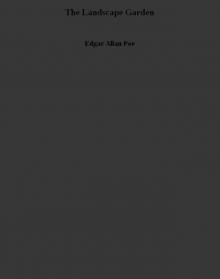 The Landscape Garden
The Landscape Garden Complete Tales & Poems
Complete Tales & Poems Great Tales and Poems of Edgar Allan Poe
Great Tales and Poems of Edgar Allan Poe The Colloquy of Monos and Una
The Colloquy of Monos and Una The Oblong Box
The Oblong Box Thou Art the Man
Thou Art the Man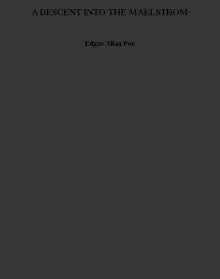 A DESCENT INTO THE MAELSTROM
A DESCENT INTO THE MAELSTROM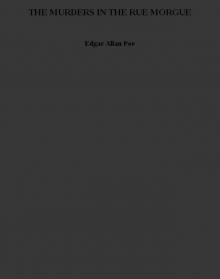 THE MURDERS IN THE RUE MORGUE
THE MURDERS IN THE RUE MORGUE The Business Man
The Business Man The Mystery of Marie Rogêt
The Mystery of Marie Rogêt Metzengerstein
Metzengerstein The Man That Was Used Up
The Man That Was Used Up William Wilson
William Wilson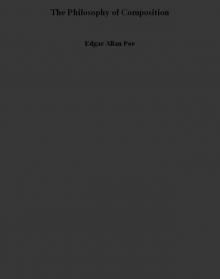 The Philosophy of Composition
The Philosophy of Composition The Portable Edgar Allan Poe
The Portable Edgar Allan Poe Bon-Bon
Bon-Bon A Predicament
A Predicament The Premature Burial
The Premature Burial The Angel of the Odd
The Angel of the Odd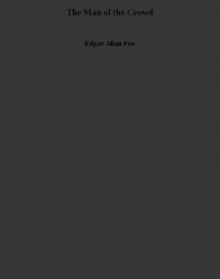 The Man of the Crowd
The Man of the Crowd Never Bet the Devil Your Head
Never Bet the Devil Your Head The Tell-Tale Heart and Other Writings
The Tell-Tale Heart and Other Writings The System of Doctor Tarr and Professor Fether
The System of Doctor Tarr and Professor Fether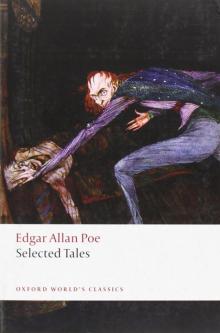 Selected Tales (Oxford World's Classics)
Selected Tales (Oxford World's Classics) Essential Tales and Poems of Edgar Allan Poe (Barnes & Noble Classics Series)
Essential Tales and Poems of Edgar Allan Poe (Barnes & Noble Classics Series) MS. Found in a Bottle
MS. Found in a Bottle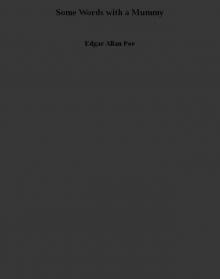 Some Words with a Mummy
Some Words with a Mummy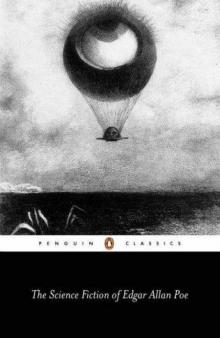 The Science Fiction of Edgar Allan Poe (Penguin Classics)
The Science Fiction of Edgar Allan Poe (Penguin Classics) King Pest
King Pest CRITICISM
CRITICISM How to Write a Blackwood Article
How to Write a Blackwood Article Mystification
Mystification Diddling Considered as One of the Exact Sciences
Diddling Considered as One of the Exact Sciences Steampunk Poe
Steampunk Poe The Literary Life of Thingum Bob, Esq.
The Literary Life of Thingum Bob, Esq.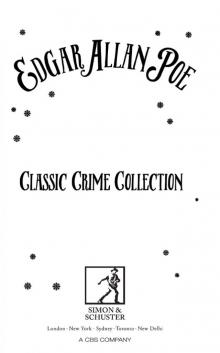 Classic Crime Collection
Classic Crime Collection Complete Stories and Poems of Edgar Allen Poe
Complete Stories and Poems of Edgar Allen Poe Berenice
Berenice The Black Cat
The Black Cat The Slender Poe Anthology
The Slender Poe Anthology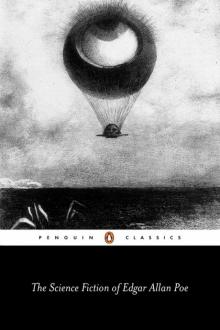 The Science Fiction of Edgar Allan Poe
The Science Fiction of Edgar Allan Poe The Assignation
The Assignation The Thousand-and-Second Tale of Scheherazade
The Thousand-and-Second Tale of Scheherazade The Raven and Other Short Stories
The Raven and Other Short Stories The Spectacles
The Spectacles Hop-Frog
Hop-Frog The Purloined Letter
The Purloined Letter Mellonta Tauta
Mellonta Tauta The Balloon-Hoax
The Balloon-Hoax Landor's Cottage
Landor's Cottage Mesmeric Revelation
Mesmeric Revelation The Pit and the Pendulum
The Pit and the Pendulum